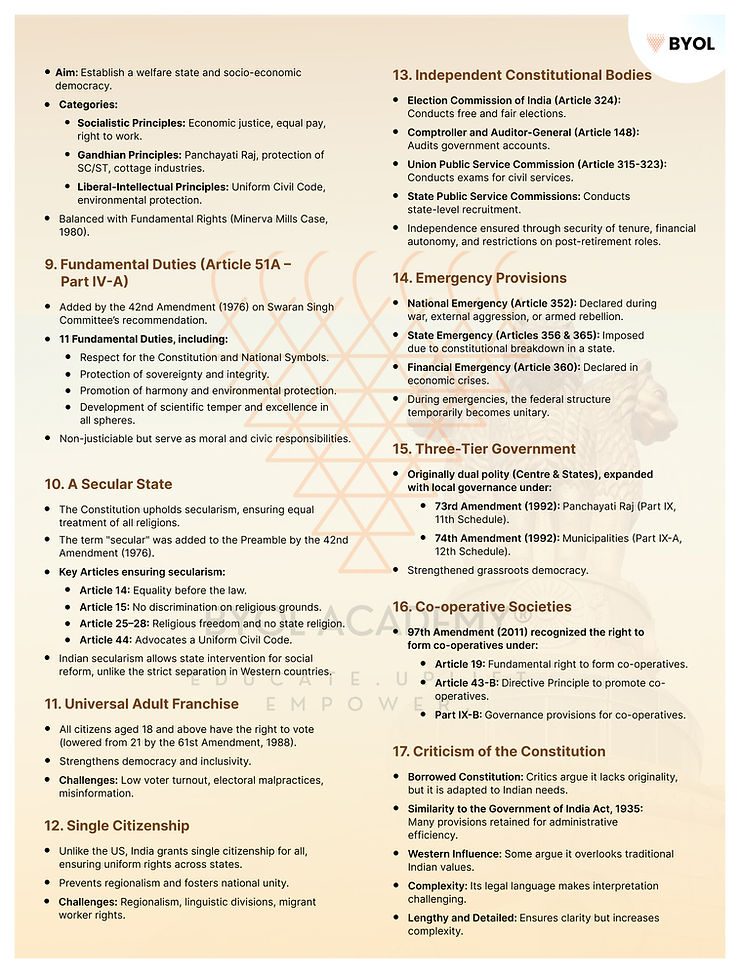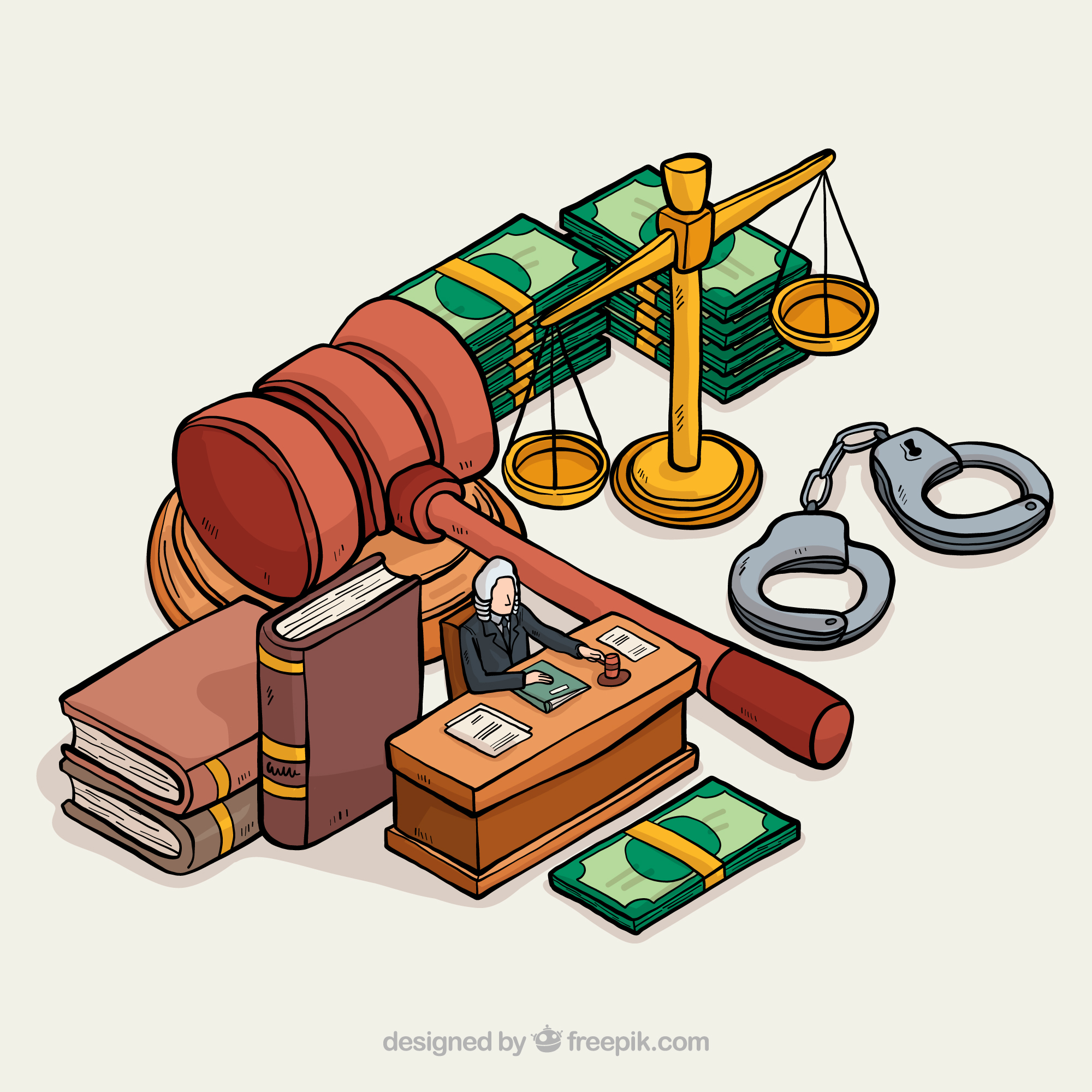Introduction
The Indian Constitution is a unique blend of borrowed principles and indigenous ideas, tailored to India’s diverse needs. While it has evolved through several amendments, the 42nd Amendment (1976) is known as the “Mini-Constitution” for introducing major changes.
However, in the Kesavananda Bharati case (1973), the Supreme Court ruled that while Parliament can amend the Constitution, it cannot alter its “basic structure.” This ensures a balance between change and stability, making the Indian Constitution both dynamic and enduring.
1. Lengthiest Written Constitution
- Unlike Britain’s unwritten constitution, India’s Constitution is the most detailed written constitution in the world.
- Originally 395 Articles in 22 Parts and 8 Schedules (1949); now 470 Articles in 25 Parts and 12 Schedules (post amendments).
- Factors contributing to its length:
- Geographical diversity – Governs a vast and diverse country.
- Historical influences – Derived from the Government of India Act, 1935.
- Single Constitution for both Centre and States – Unlike the U.S., where each state has its own constitution.
- Legal experts in the Constituent Assembly – Preferred detailing over ambiguity.
2. Drawn from Various Sources
The Indian Constitution is often called a “bag of borrowings”, as it incorporates elements from multiple global constitutions:
| Source | Provisions Borrowed |
| Government of India Act, 1935 | Federal structure, emergency provisions, judiciary, governance structure. |
| British Constitution | Parliamentary system, Rule of Law, Bicameralism, Cabinet government. |
| US Constitution | Fundamental Rights, Judicial Review, Impeachment, Independence of the judiciary. |
| Irish Constitution | Directive Principles of State Policy (DPSP), Presidential election method. |
| Canadian Constitution | Strong Centre, Residuary powers, Appointment of Governors. |
| Australian Constitution | Concurrent List, Trade & Commerce provisions, Joint Sitting of Parliament. |
| Weimar (German) Constitution | Emergency provisions, Suspension of Fundamental Rights. |
| Soviet (USSR) Constitution | Fundamental Duties, Socialist ideals. |
| French Constitution | Republic, Ideals of Liberty, Equality, and Fraternity. |
| Japanese Constitution | “Procedure established by law” in Article 21 (Right to Life). |
3. Blend of Rigidity and Flexibility
- Rigid Constitution – Certain provisions require special majority + state ratification (e.g., federal structure amendments under Article 368).
- Flexible Constitution – Some provisions can be amended by simple majority (e.g., parliamentary procedures, citizenship laws).
4. Synthesis of Parliamentary Sovereignty and Judicial Supremacy
- British Influence: The doctrine of parliamentary sovereignty is derived from the British Parliament, where laws passed by Parliament are supreme and cannot be questioned.
- American Influence: Judicial supremacy, as seen in the U.S., allows courts to strike down laws that violate the Constitution.
- Indian Context: India has a balanced synthesis of both principles:
- The Supreme Court can review and declare parliamentary laws unconstitutional through judicial review.
- The Parliament can amend major portions of the Constitution using its constituent power (except the Basic Structure Doctrine).
- Key Difference:
- The U.S. follows “due process of law”, which gives broader judicial review power.
- India follows “procedure established by law” (Article 21), limiting judicial interference unless laws violate fundamental rights.
5. Integrated and Independent Judiciary
- Unified Judicial System:
- Unlike the U.S., which has separate federal and state courts, India has a single integrated system enforcing both central and state laws.
- Hierarchy of Courts:
- Supreme Court (Apex Court)
- High Courts (State Level)
- District & Subordinate Courts (Lower Judiciary)
- Functions of the Supreme Court:
- Federal Court (settles disputes between the Union and States).
- Highest Court of Appeal (final decision on civil & criminal cases).
- Protector of Fundamental Rights (issues writs under Article 32).
- Guardian of the Constitution (ensures constitutional supremacy).
- Provisions Ensuring Independence:
- Security of tenure (judges cannot be easily removed).
- Fixed service conditions (salary and perks cannot be reduced).
- Expenses charged on Consolidated Fund of India (no executive interference).
- No discussion on judge’s conduct in Parliament (except impeachment cases).
- Ban on post-retirement practice (to avoid conflict of interest).
- Power to punish for contempt of court (ensuring authority).
- Separation of Judiciary from Executive (Article 50).
6. Fundamental Rights (Part III: Articles 12–35)
Nature and Importance:
- Promote Political Democracy and prevent government overreach.
- Justiciable – citizens can directly approach courts if rights are violated.
- Limitations on Executive and Legislature – prevents arbitrary actions.
Six Fundamental Rights:
- Right to Equality (Articles 14–18)
- Article 14: Equality before law & equal protection of laws.
- Articles 15–16: Prohibition of discrimination & equality of opportunity.
- Article 17: Abolition of Untouchability.
- Article 18: Abolition of Titles (except military/academic).
- Right to Freedom (Articles 19–22)
- Article19: Six freedoms (speech, assembly, association, movement, residence, profession).
- Article 20: Protection against self-incrimination & retrospective laws.
- Article20: Right to Life & Personal Liberty (expanded through judicial interpretation).
- Article 22: Protection against arbitrary arrest & detention.
- Right against Exploitation (Articles 23–24)
- Prohibits human trafficking, forced labour & child labour.
- Right to Freedom of Religion (Articles 25–28)
- Freedom of conscience and right to practice, profess, and propagate religion.
- Cultural & Educational Rights (Articles 29–30)
- Protects minority rights to establish and administer educational institutions.
- Right to Constitutional Remedies (Article 32)
- Heart and soul of the Constitution (Dr. B.R. Ambedkar).
- Supreme Court can issue writs:
- Habeas Corpus – unlawful detention.
- Mandamus – directing officials to perform their duties.
- Prohibition – stopping lower courts from exceeding jurisdiction.
- Certiorari – transferring a case to a higher court.
- Quo Warranto – questioning a person’s legal authority to hold an office.
Limitations on Fundamental Rights:
- Not Absolute – subject to reasonable restrictions.
- Can be curtailed/repealed by Parliament (except Basic Structure).
- Suspended during National Emergency (except Articles 20 & 21).
7. Directive Principles of State Policy (DPSP) – Part IV
- Inspired by the Irish Constitution and Gandhian philosophy.
- Aim: To establish social and economic democracy and a welfare state.
- Not justiciable (courts cannot enforce them).
- State’s duty to apply them in policymaking (Article 37).
- Moral and political obligation rather than a legal one.
Classification of DPSPs:
- Socialist Principles:
- Article 38: Promote welfare state.
- Article 39: Ensure equal pay, adequate livelihood, fair distribution of wealth.
- Article 41: Right to work, education, and public assistance.
- Article 43: Living wage for workers.
- Article 47: Improve public health, ban intoxicating drinks and drugs
- Gandhian Principles:
- Article 40: Establish Panchayati Raj institutions.
- Article 43: Promote cottage industries.
- Article 46: Protect SC/ST and weaker sections.
- Article 48: Prohibit cow slaughter.
- Liberal-Intellectual Principles:
- Article 44: Uniform Civil Code (UCC).
- Article 45: Free and compulsory education (originally up to 14 years).
- Article 48A: Protect and improve the environment.
Significance of DPSPs:
- Provides policy guidance for governance.
- Creates socio-economic justice.
- Ensures balanced development of all sections of society.
Fundamental Rights vs. DPSP:
- Minerva Mills Case (1980):
- Balance between FRs & DPSP is the Basic Structure of the Constitution.
- Neither can override the other completely.
- Judicial interpretation ensures harmony between both.
8. Fundamental Duties (Part IV-A, Article 51A)
- Originally, the Constitution did not include Fundamental Duties.
- Added by the 42nd Constitutional Amendment Act, 1976 on the recommendation of the Swaran Singh Committee during the Emergency.
- The 86th Constitutional Amendment Act, 2002 added the 11th Fundamental Duty (compulsory education for children).
- Found in Part IV-A (Article 51A) of the Constitution.
List of 11 Fundamental Duties:
- Respect the Constitution, National Flag, and National Anthem.
- Follow and uphold the ideals of the freedom struggle.
- Protect sovereignty, unity, and integrity of India.
- Defend the country and render national service when required.
- Promote harmony and the spirit of common brotherhood.
- Preserve the rich heritage of Indian culture.
- Protect and improve the natural environment.
- Develop scientific temper, humanism, and spirit of inquiry.
- Safeguard public property and avoid violence.
- Strive towards excellence in all spheres of life.
- Ensure education for children between 6-14 years (added by 86th Amendment, 2002).
Significance of Fundamental Duties:
- Remind citizens that rights come with responsibilities.
- Promote patriotism and discipline among citizens.
- Strengthen national unity and integrity.
- Though non-justiciable, they act as a moral obligation for citizens.
- Serve as a yardstick for interpreting Fundamental Rights in legal cases.
9. A Secular State
- India is a secular state, meaning no religion is recognized as the state religion.
- The term “secular” was added to the Preamble by the 42nd Constitutional Amendment Act, 1976.
Constitutional Provisions Establishing Secularism:
- Preamble: Guarantees liberty of belief, faith, and worship.
- Article 14: Equality before law, no religious discrimination.
- Article 15: No discrimination on grounds of religion.
- Article 16: Equal opportunity in public employment.
- Article 25: Freedom of conscience, right to profess, practice, and propagate religion.
- Article 26: Religious denominations can manage their affairs.
- Article 27: No taxation for promoting a specific religion.
- Article 28: No religious instruction in government-funded institutions.
- Article 29: Protection of distinct language, script, or culture.
- Article 30: Minorities’ right to establish and administer educational institutions.
- Article 44: Uniform Civil Code (UCC) – A directive principle to ensure a common personal law system.
Indian Secularism vs. Western Secularism:
| Western Secularism (U.S., France) | Indian Secularism |
| Strict separation of religion and state | Equal treatment of all religions |
| No state intervention in religious matters | State can regulate religious practices if against public welfare |
| Church and State are completely separate | State promotes religious harmony but does not favour any religion |
Key Observations:
- Indian secularism follows “Sarva Dharma Sambhava” (equal respect for all religions).
- Unlike the West, the State can intervene in religious matters for social reform (e.g., abolition of untouchability, Triple Talaq ban).
- No communal representation in legislatures (unlike pre-independence era).
10. Universal Adult Franchise
- Every Indian citizen aged 18 and above has the right to vote.
- Introduced in 1950, when many countries still had property-based or gender-restricted voting rights.
- The 61st Constitutional Amendment Act, 1988 reduced the voting age from 21 to 18 years (effective in 1989).
Significance of Universal Adult Franchise:
- Promotes democracy by making elections inclusive.
- Empowers weaker sections (SCs, STs, women, minorities).
- Strengthens national unity by treating all voters equally.
- Encourages political participation and awareness.
Challenges:
- Low voter turnout due to apathy and lack of awareness.
- Use of money & muscle power in elections.
- Illiteracy and misinformation affecting voting choices.
- Booth capturing and election malpractices in some areas.
11. Single Citizenship
- Unlike the U.S. (where citizens have dual citizenship – federal and state), India has only single citizenship.
- Any Indian citizen can reside, work, or contest elections anywhere in the country.
- Ensures national unity and equal rights for all citizens.
Advantages of Single Citizenship:
- Promotes national integration (no division based on state identity).
- Prevents regionalism and separatism.
- Equal rights and responsibilities across India.
Challenges & Concerns:
- Regionalism & Linguistic Conflicts (e.g., North-South divide, demand for separate states).
- Rise of sub-nationalism (e.g., local preference in government jobs).
- Violation of migrant workers’ rights in some states.
12. Independent Bodies
The Constitution establishes several independent institutions to safeguard democracy:
- Election Commission of India (ECI) (Article 324)
- Conducts free and fair elections for Parliament, State Assemblies, President & Vice-President.
- Ensures model code of conduct.
- Resolves election disputes and enforces anti-defection laws.
- Comptroller and Auditor-General of India (CAG) (Article 148)
- Audits government accounts (Union & States).
- Reports financial irregularities to Parliament.
- Acts as the “guardian of the public purse”.
- Union Public Service Commission (UPSC) (Article 315-323)
- Conducts recruitment exams for All India Services & Central Government Services.
- Ensures merit-based selection and fairness in hiring.
- State Public Service Commission (SPSC)
- Conducts recruitment exams for state government jobs.
- Advises the President on disciplinary matters.
- Provisions Ensuring Independence of These Bodies:
- Security of tenure (cannot be arbitrarily removed).
- Fixed service conditions (salaries cannot be reduced).
- Expenses charged on Consolidated Fund of India (to prevent executive influence).
- No reappointment after retirement (prevents conflict of interest).
13. Emergency Provisions The Constitution provides for three types of emergencies:
- National Emergency (Article 352): Declared during war, external aggression, or armed rebellion.
- State Emergency (Article 356 & 365): Imposed due to the failure of constitutional machinery in states.
- Financial Emergency (Article 360): Declared during financial instability.
During emergencies, the federal structure transforms into a unitary system, centralizing power with the Union Government.
14.Three-Tier Government
Initially, India had a dual polity (Centre and States), but the 73rd and 74th Amendments (1992) introduced a third tier—local government.
- 73rd Amendment: Added Part IX and the 11th Schedule, recognizing Panchayati Raj institutions.
- 74th Amendment: Added Part IX-A and the 12th Schedule, recognizing Municipalities.
These amendments enhanced grassroots democracy and decentralized governance.
15. Co-operative Societies
The 97th Constitutional Amendment Act of 2011 granted constitutional status to co-operative societies:
- Article 19: Recognized the right to form co-operatives as a fundamental right.
- Article 43-B: Added a new Directive Principle for promoting co-operatives.
- Part IX-B: Introduced Articles 243-ZH to 243-ZT for better governance of co-operatives.
16. Criticism of the Constitution
- A Borrowed Constitution Critics argue that the Constitution is a ‘bag of borrowings’ from various sources. However, the framers adopted these borrowed elements to suit India’s unique conditions.
- A Carbon Copy of the 1935 Act Many provisions are derived from the Government of India Act, 1935. However, these provisions were retained due to their administrative efficacy.
- Un-Indian or Anti-Indian Some critics claim that the Constitution lacks Indian ethos and is influenced by Western ideals. However, it incorporates various traditional elements alongside modern principles.
- An Un-Gandhian Constitution Gandhian principles like decentralized governance and self-sufficient villages were not fully incorporated. However, later amendments strengthened local governance structures.
- Elephantine Size The Constitution is one of the longest in the world, with excessive details. However, its complexity ensures clarity in governance and reduces ambiguity.
- Paradise of the Lawyers The Constitution’s legalistic language makes it complex. While critics argue it fosters excessive litigation, its detailed nature ensures a robust legal framework.






